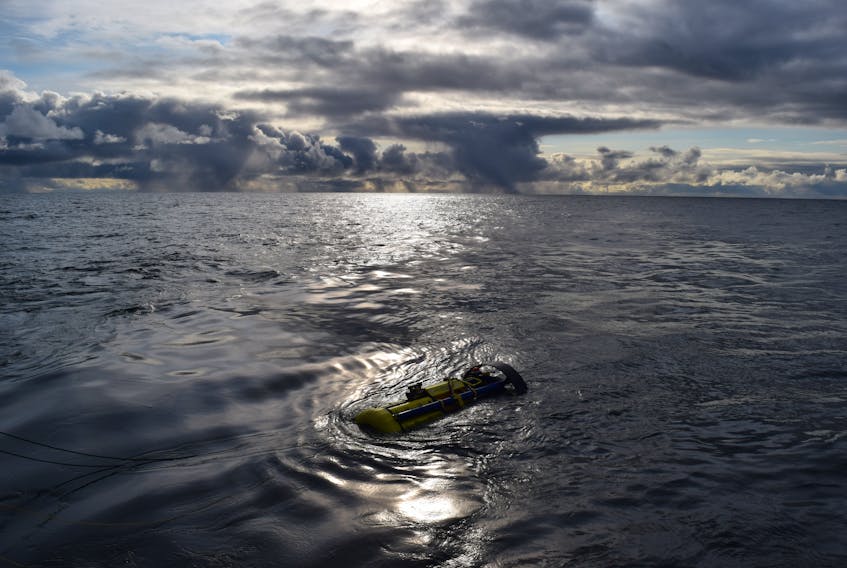
The Labrador Sea is, to put it mildly, not hospitable to human life in winter. It’s 841,000 square kilometres of water that, thanks to the magic of salinity, averages -1 degree Celsius. Plus, there are waves, wind, ice, and isolation.
But it also plays a pivotal role in shaping global ocean currents and acts as an interface between atmosphere and ocean.
“It is important and interesting to study, but it’s also a very challenging environment to work in,” says Dariia Atamanchuk, an associate researcher at Dalhousie University in Halifax. “Seasonality is brutal there. You cannot do any kind of ship expedition between November and May. Very violent environment, big waves, and high currents. So, we rely on platforms like SeaCycler to do measurements for us.”
The SeaCycler is a cylinder about 15 feet long and five feet high. It weighs 1,200 pounds and looks like the offspring of a jet engine and a yellow highlighter. It's the result of a collaboration between the Bedford Institute of Oceanography (DFO, Canada), the Scripps Institution of Oceanography (USA), the University of Bremen (Germany), GEOMAR - Helmholtz Centre for Ocean Research Kiel (Germany), and Dalhousie University’s CERC.OCEAN group.
Sea secrets

Atamanchuk’s area of expertise is in the sensors housed in the cylinder, which measure oxygen and carbon dioxide concentration, current velocity, and nitrate concentrations, among other things, and where she entered the project after moving here from Sweden in 2015.
“My role was to look after the sensors to make sure that they’re performing as they should. They’re calibrated, they’re ready to go. And, of course, analyze the data that comes after the deployment.”
The SeaCycler is attached to a 3.5-kilometre cable. One end is anchored on the ocean floor, allowing the SeaCycler to move up and down 150 metres to take samples at different depths. Although it lacks the flexibility of ship research, the SeaCycler makes up for that in sheer volume over the year it's deployed.
While a ship allows researchers to collect water samples for analysis, weather would halt researchers for much of the year. SeaCycler increases the amount of measurements dramatically.
“But it comes at a cost: we have to keep an eye on those sensors. We have to develop techniques in order to show that the sensor data is as good as laboratory data.”
A communications float allows the SeaCycler to periodically send data back to shore. Waiting for these communications is stressful for Atamanchuk and the rest of the researchers on the team.
“It’s nerve-wracking. It’s like ‘Oh, the cycler called! It’s working well! Phew’,” says Atamanchuk. “If something happens in the middle of the winter, if it stops working for any reason, there is nothing we can do. We just accept the fact that something is wrong, and we will come back and retrieve it next time we’re there.”
Ocean oxygenation

The upper layers of the ocean are important to understanding climate change because it is the interface between the atmosphere and the deep ocean. Gases in the atmosphere are absorbed into the upper layer and transmitted to deep water. The Labrador Sea is one of only a few places on Earth where oxygen, for example, is transmitted directly from the atmosphere into the deep ocean.
SeaCycler is helping researchers understand that process, just as climate change threatens the continued existence of this exchange channel.
A paper based on the instrument’s first deployment, which Atamanchuk co-authored, was recently published in the journal Nature Geoscience.
“It can help us to understand the oxygenation of the ocean. I would say it’s been delivering some really interesting data,” Atamanchuk says.
She’s currently working on a second paper, looking at how much carbon dioxide is being transported to the deep ocean from the atmosphere and how the process is vulnerable and sensitive to climate change.

Atamanchuk is driven by the possibility that the information SeaCycler gathers might help us better understand some piece of the climate change puzzle.
“It’s one of the biggest motivations of work is that we know that we are contributing to... not solving the problem, but understanding the ocean. Once you understand how it works you can make decisions. What can you do in order to mitigate one effect or amplify the other?” she says.
“I think it’s the largest motivation of any oceanographer or climate scientist, is being useful and contributing to the bigger picture.”
In recognition of World Meteorological Day on March 23, SaltWire Network is looking at a series of stories this week.









